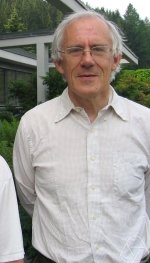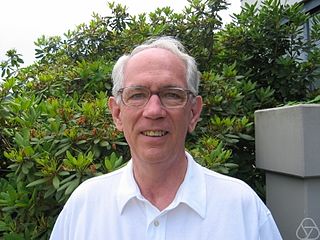Combinatorics is an area of mathematics primarily concerned with counting, both as a means and an end in obtaining results, and certain properties of finite structures. It is closely related to many other areas of mathematics and has many applications ranging from logic to statistical physics and from evolutionary biology to computer science.

Discrete mathematics is the study of mathematical structures that can be considered "discrete" rather than "continuous". Objects studied in discrete mathematics include integers, graphs, and statements in logic. By contrast, discrete mathematics excludes topics in "continuous mathematics" such as real numbers, calculus or Euclidean geometry. Discrete objects can often be enumerated by integers; more formally, discrete mathematics has been characterized as the branch of mathematics dealing with countable sets. However, there is no exact definition of the term "discrete mathematics".

In mathematics, a permutation group is a group G whose elements are permutations of a given set M and whose group operation is the composition of permutations in G (which are thought of as bijective functions from the set M to itself). The group of all permutations of a set M is the symmetric group of M, often written as Sym(M). The term permutation group thus means a subgroup of the symmetric group. If M = {1, 2, ..., n} then Sym(M) is usually denoted by Sn, and may be called the symmetric group on n letters.
A computer algebra system (CAS) or symbolic algebra system (SAS) is any mathematical software with the ability to manipulate mathematical expressions in a way similar to the traditional manual computations of mathematicians and scientists. The development of the computer algebra systems in the second half of the 20th century is part of the discipline of "computer algebra" or "symbolic computation", which has spurred work in algorithms over mathematical objects such as polynomials.
Magma is a computer algebra system designed to solve problems in algebra, number theory, geometry and combinatorics. It is named after the algebraic structure magma. It runs on Unix-like operating systems, as well as Windows.

Computational physics is the study and implementation of numerical analysis to solve problems in physics. Historically, computational physics was the first application of modern computers in science, and is now a subset of computational science. It is sometimes regarded as a subdiscipline of theoretical physics, but others consider it an intermediate branch between theoretical and experimental physics — an area of study which supplements both theory and experiment.
In mathematics and computer science, computational number theory, also known as algorithmic number theory, is the study of computational methods for investigating and solving problems in number theory and arithmetic geometry, including algorithms for primality testing and integer factorization, finding solutions to diophantine equations, and explicit methods in arithmetic geometry. Computational number theory has applications to cryptography, including RSA, elliptic curve cryptography and post-quantum cryptography, and is used to investigate conjectures and open problems in number theory, including the Riemann hypothesis, the Birch and Swinnerton-Dyer conjecture, the ABC conjecture, the modularity conjecture, the Sato-Tate conjecture, and explicit aspects of the Langlands program.
In mathematics, coset enumeration is the problem of counting the cosets of a subgroup H of a group G given in terms of a presentation. As a by-product, one obtains a permutation representation for G on the cosets of H. If H has a known finite order, coset enumeration gives the order of G as well.
The Schreier–Sims algorithm is an algorithm in computational group theory, named after the mathematicians Otto Schreier and Charles Sims. This algorithm can find the order of a finite permutation group, test membership, and many other tasks in polynomial time. It was introduced by Sims in 1970, based on Schreier's subgroup lemma. The timing was subsequently improved by Donald Knuth in 1991. Later, an even faster randomized version of the algorithm was developed.
In mathematics, a combinatorial class is a countable set of mathematical objects, together with a size function mapping each object to a non-negative integer, such that there are finitely many objects of each size.
In mathematics, especially the field of computational group theory, a Schreier vector is a tool for reducing the time and space complexity required to calculate orbits of a permutation group.
Let be a finite permutation group acting on a set . A sequence
A logical matrix, binary matrix, relation matrix, Boolean matrix, or (0, 1)-matrix is a matrix with entries from the Boolean domain B = {0, 1}. Such a matrix can be used to represent a binary relation between a pair of finite sets. It is an important tool in combinatorial mathematics and theoretical computer science.

Charles R. Leedham-Green is a retired professor of mathematics at Queen Mary, University of London, known for his work in group theory. He completed his DPhil at the University of Oxford.

Charles Coffin Sims was an American mathematician best known for his work in group theory. Together with Donald G. Higman he discovered the Higman–Sims group, one of the sporadic groups. The permutation group software developed by Sims also led to the proof of existence of the Lyons group and the O'Nan group.
In mathematics, more specifically in computational algebra, a straight-line program (SLP) for a finite group G = ⟨S⟩ is a finite sequence L of elements of G such that every element of L either belongs to S, is the inverse of a preceding element, or the product of two preceding elements. An SLP L is said to compute a group element g ∈ G if g ∈ L, where g is encoded by a word in S and its inverses.

In computational group theory, a black box group is a group G whose elements are encoded by bit strings of length N, and group operations are performed by an oracle. These operations include:
Bettina Eick is a German mathematician specializing in computational group theory. She is Professor of Mathematics at the Technische Universität (TU) Braunschweig.

William M. Kantor is an American mathematician who works in finite group theory and finite geometries, particularly in computational aspects of these subjects.





